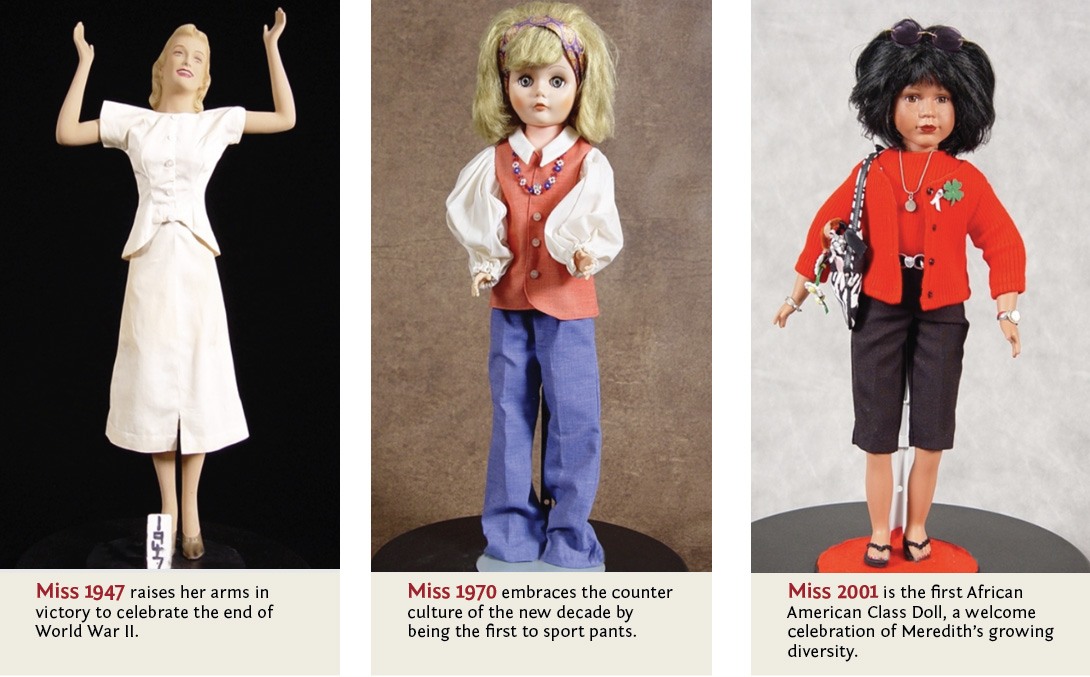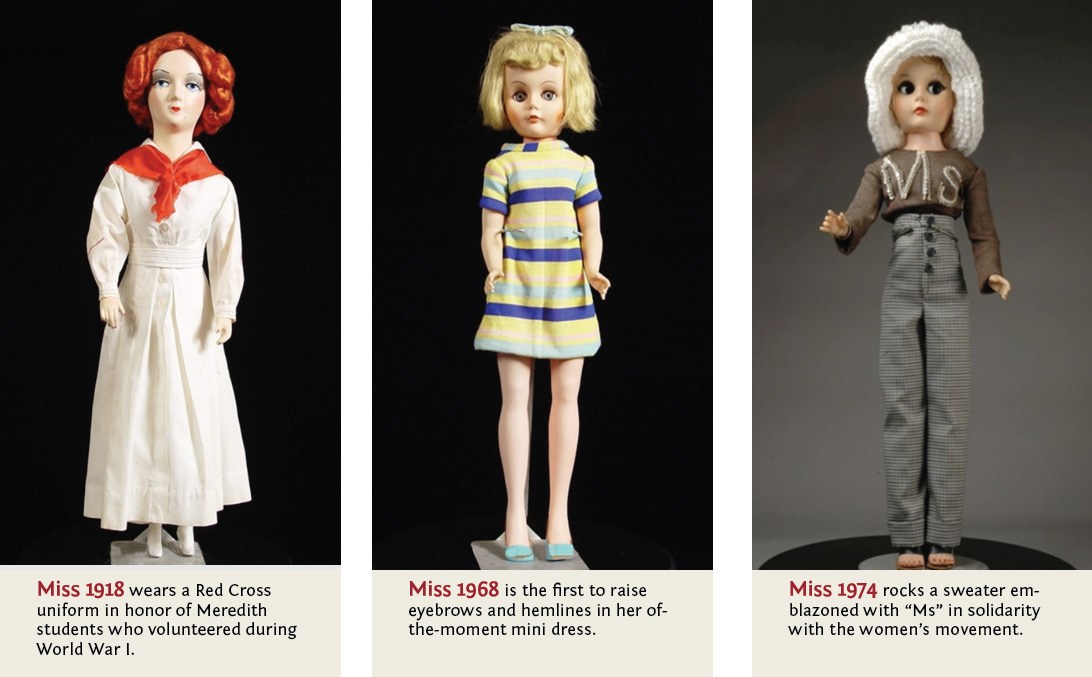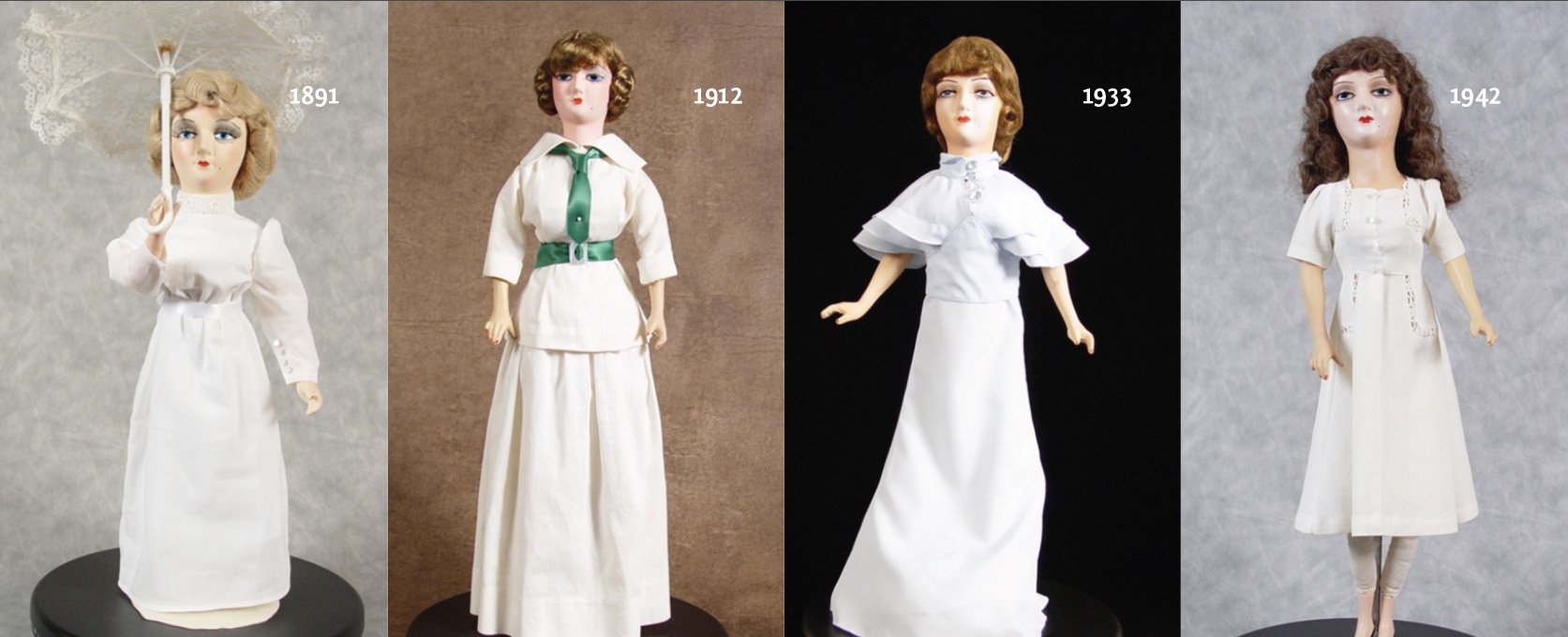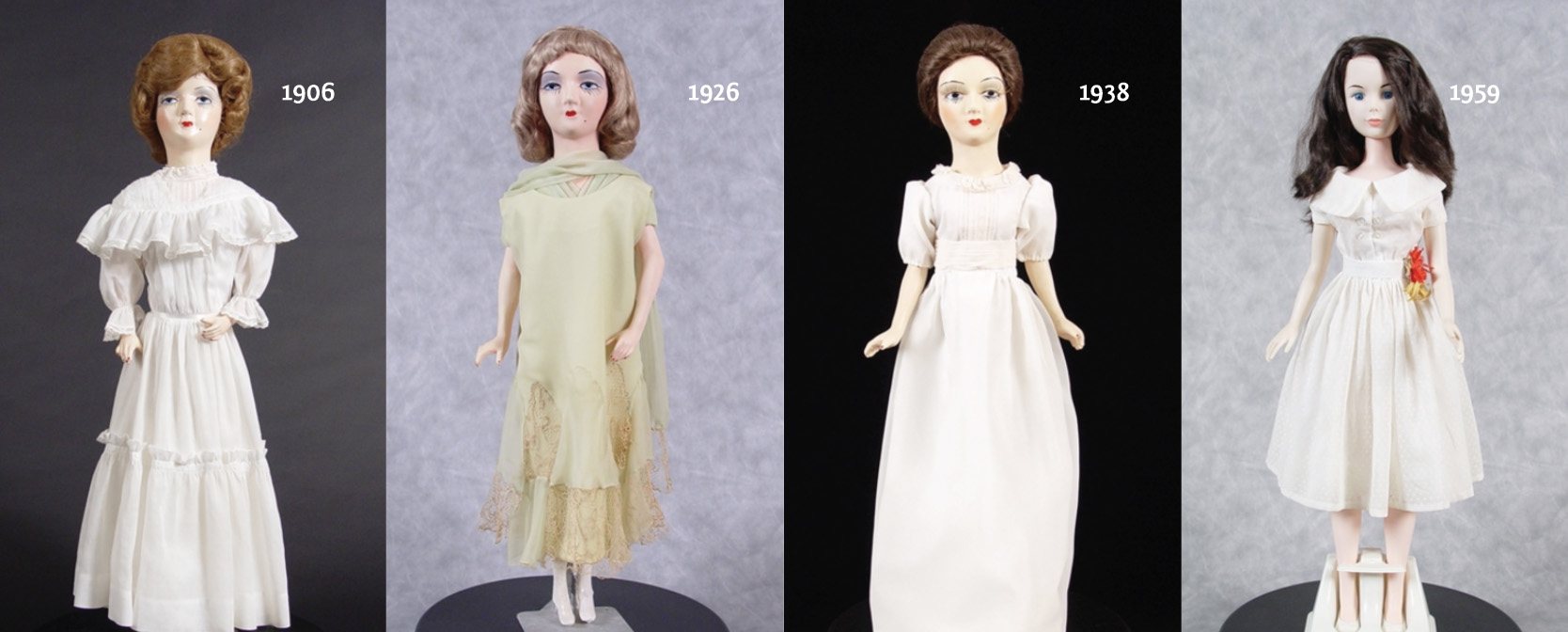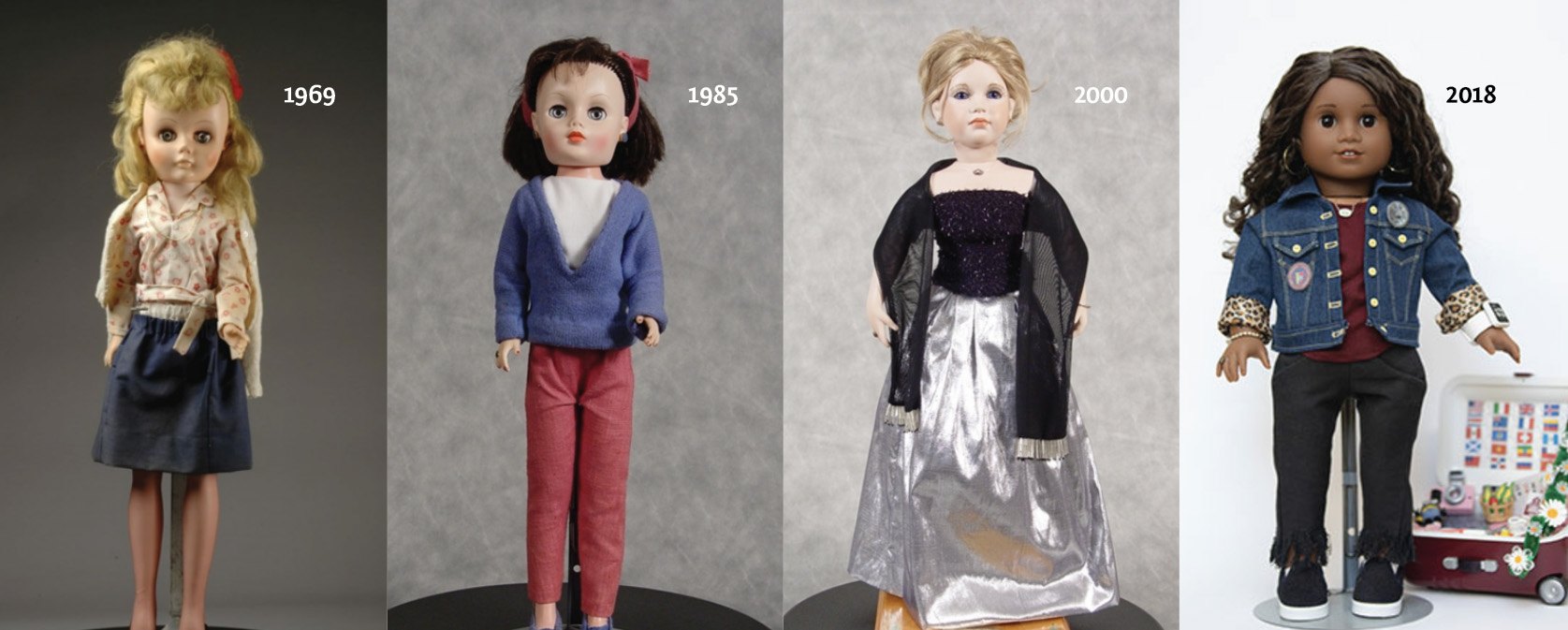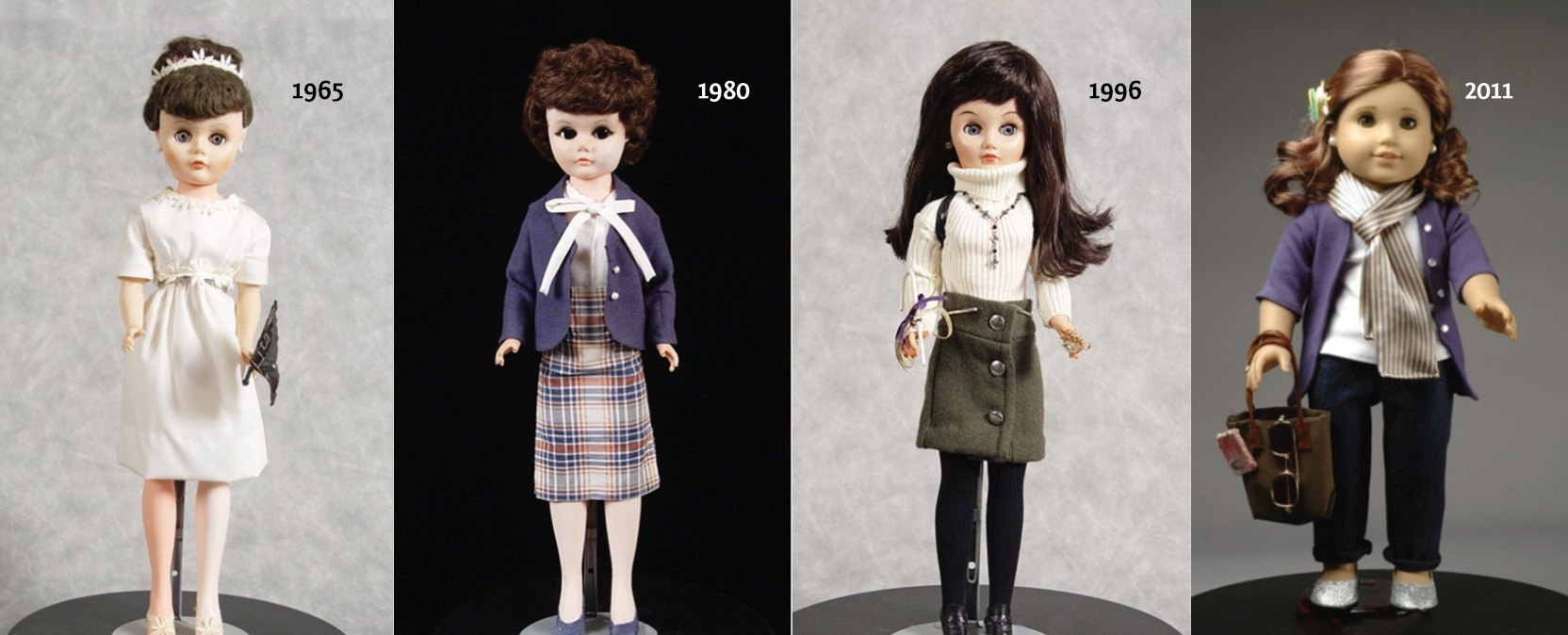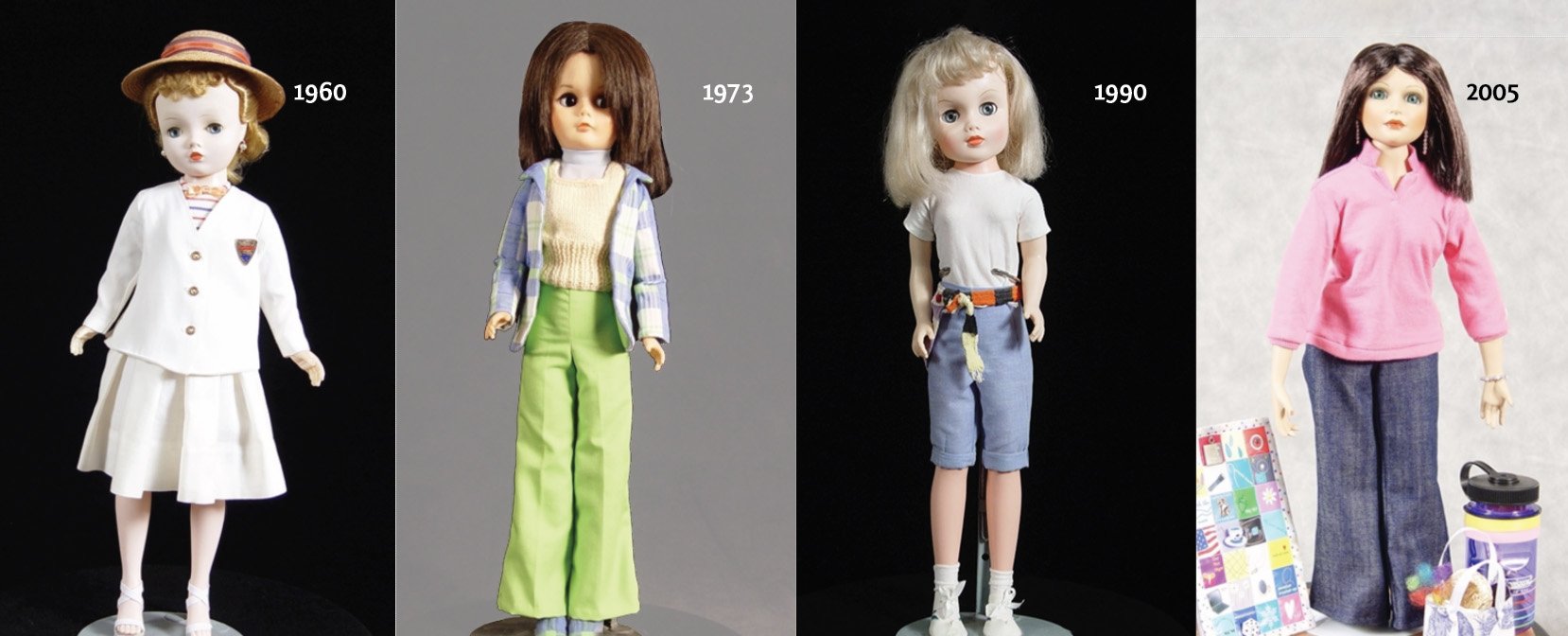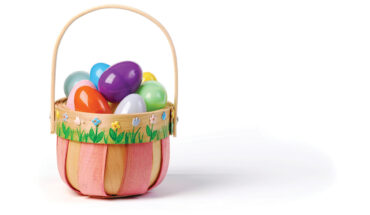A quirky tradition at Meredith College, more than 100 years in the making, reveals history in an unexpected way.
by Lori D.R. Wiggins | photographs courtesy Meredith College
Should you step into Meredith College’s Johnson Hall Administration Building, look up. There, lining the walls on the third floor of the rotunda, you’ll see the Margaret Bright Gallery of Class Dolls. Get closer. Lean in. The collection is a peek into life at Meredith and beyond over a century (119 years, to be exact) serving as a fascinating time capsule.
From her style and accessories to her name and belongings, each doll represents what that year’s senior class experienced while at Meredith. Think: wars, natural disasters, elections, social movements, fashion trends, technology, altered educational and environmental landscapes. There are nods to history-makers, on- and off-campus life; trinkets that distinguish their class and celebrate all Meredith girls; homages to diversity, study abroad and LGBTQ+ acceptance; and tributes to folks in the Meredith family. Through her style, name and story, each doll holds clues to what each class loved, lost and learned. “Each doll really tells a story,” says Hilary Allen, Meredith’s director of Alumnae Relations and a 2001 graduate of the school. The Meredith Class Dolls tradition started in 1936, after Elizabeth Briggs Pittman, a leader in the Baptists’ Woman’s Missionary Union, suggested the idea to the alumnae association, says Carrie Nichols, Meredith’s archivist and technology head. (Pittman herself was not a Meredith alumna.) Alumnae and representatives from the classes of 1902 to 1935 joined the tradition, creating dolls symbolic of their own college generations for the collection. Every senior class since then has presented a doll to the alumnae association at their induction ceremony during May’s graduation festivities.
Click to expand slideshow.
Like a mirror to society, the Class Dolls reflect the mood of a generation through the evolution of trends in fashion and accessories, while also revealing notable shifts in culture, politics and social and gender norms.
The Class Dolls of the earlier years mostly don long, white dresses like the ones graduates wore on Class Day, but as the years go on, the colors, styles—and hemlines!—evolve (though the real-life women still wear white on Class Day). Miss 1918 wears a Red Cross uniform to salute Meredith’s student volunteers during World War I, while Miss 1947 raises her arms in victory soon after WWII. The hemlines first rise to mini-skirt status for Miss 1968 and Miss 1969—but Miss 1970 wears the first pair of pants with her shag haircut. Miss 1974 sports a sweater emblazoned with “Ms.”—a tribute to the women’s movement—and Miss 1976 is the first Class Doll to have pierced ears.
 The class doll of 1982 was among the first to have a name, Nancy Diana, in honor of former First Lady Nancy Regan and Princess Diana of Wales, “two of the most recognizable and influential women in the world at that time,” her story says. The Class of 1991 presented Beverly Clark, named after the first American woman killed in action during Operation Desert Storm.
The class doll of 1982 was among the first to have a name, Nancy Diana, in honor of former First Lady Nancy Regan and Princess Diana of Wales, “two of the most recognizable and influential women in the world at that time,” her story says. The Class of 1991 presented Beverly Clark, named after the first American woman killed in action during Operation Desert Storm.
In 2001, seniors introduced the collection’s first African American doll, Cynthia Jo Hanna, to celebrate Meredith’s growing diversity. Her first name is derived from ‘centennial,’ because the class was the 100th to graduate; her middle name honors class advisor Jo Guglielmi, and her last name remembers beloved professor Sandra Hanner, who died of cancer in Spring 2001. In 2005, there’s Asia Grace McKay Fletcher, representing the Tsunami disaster that happened that year. As for her name: Grace is symbolic of how the class “gracefully handled stressful situations;” McKay honors Ruth McKay, the class of 1905’s president; and Fletcher matches the last name of that year’s class advisor.
“Sometimes the dolls represent things larger than themselves,” said Jean Jackson, a 1975 Meredith alumna who is now Vice President for College Programs and an English professor. Over the years, she said, she’s grown an appreciation for what the dolls reveal culturally. (Her year’s Class Doll wears a lapel pen that’s a replica of one that symbolized the International Day of the Woman.)
“And some of the styles are hilarious,” quips Jackson, pointing out that Miss 1975 also wears a light-orange polyester skirt. Other styles are likely eye-opening to younger generations. “I often tell students they can see through the dolls just how short their mama’s and grandmama’s skirts were!”
Looking back, Allen says, she can pinpoint where the focus of fashion transitioned from being a matter of status and “fitting in” to more of a statement about fashion fluidity, finding your own style and acceptance.
“It always fascinates people to see the earliest dolls, then to see the development over time—how much diversity has come through the years,” says Allen. “But it’s not just the changing of styles, there’s a whole mood that changes when you see the whole collection.” As she tells students: “This is a snapshot indicative of your time at Meredith College, from the way you dressed to the things you rebelled against.”
Their first caretaker was Margaret Bright, a Meredith faculty member and alumna of the Class of 1907. Before the glass and wooden cases became their home, Bright would take the dolls out of storage each year, fluff their clothes and spruce their hair for display on Class Day, the day before graduation. Bright never missed a Meredith graduation and cared for the dolls until her death in 1969. The gallery was established in her name in 1972. Last October, an eleventh case was donated by two former roommates and Meredith alumnae of 1977, in honor of their mothers, who also were roommates and 1947 Class Doll co-chairs.
 Taylor Twine is a 2013 graduate of Meredith who has advised the Class Dolls co-chairs for the past three years. The focus, she says, is to build bonds among classes and across generations as students work to “tell the story of their class for themselves and for the classes before and after.”
Taylor Twine is a 2013 graduate of Meredith who has advised the Class Dolls co-chairs for the past three years. The focus, she says, is to build bonds among classes and across generations as students work to “tell the story of their class for themselves and for the classes before and after.”
Always a doll lover, Anna Griffin, the class of 2020 doll co-chair, grew a quick affinity for Meredith’s Class Dolls her freshman year. Along with co-chair and classmate Morgan Johnson, this year they sent surveys to all class members for their input. Until her official unveiling, Miss 2020 is a secret, but Griffin shared that Miss 2020 may include a nod to a visit by U.S. Supreme Court Justice Ruth Bader Ginsburg, voting (the class entered and exits Meredith in presidential election years), the solar eclipse, the centennial of the 19th Amendment and the Big Sis, Little Sis program that pairs freshmen students with juniors. “I’m excited to see how our idea has come together,” Griffin said.
No doubt, the Meredith Class Dolls rank high among a cache of time-honored Meredith traditions, said senior Alayna Schwenker. “It’s a great tradition, and one of the major ways Meredith highlights the diversity of our campus,” she said. “The dolls represent thoughts from everyone and include everybody’s voices. It brings people together, and makes us all feel part of something.


